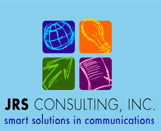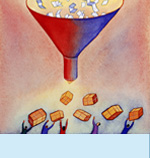Meeting Facilitation 9-1-1:
How to Reach a Verdict in Every Meeting
The most urgent meeting facilitation training that I have ever conducted occurred when the jury I was serving on went into deliberation in a first degree murder trial. For two days we had listened to convicted felons describe a drug deal gone bad, examined bullets, reviewed photographs of the deceased's fatal wounds, and listened to forensic experts' testimony. Closing arguments were made, and we retired to the jury room for deliberations.
And then the pressure was on. An initial vote showed a jury divided. Chaos broke out as individuals or small groups within the jury competed to explain their views. A foursome of strong personalities excitedly sketched out the crime scene on a whiteboard and debated about the paths of the bullets. Others recounted their own tales of traffic tickets and near arrests. A former gang member demonstrated various signs and "walks" that indicate gang affiliations. Soft-spoken jurors struggled to share their thoughts.
This was the nightmare of all meetings — we were locked in a room all day long, faced with an absolutely critical decision that could only be made by the unanimous agreement of 12 complete strangers from all walks of life. It was a runaway jury — the mild-mannered foreman, overwhelmed by the task at hand, had completely lost control of the group.
Failing to reach an agreement on day one of deliberations, we were unexpectedly sequestered. Completely cut off from contact with anyone in the "outside world," we were transported 45 minutes away in a van normally used for prisoners, guarded constantly by sheriffs, and assigned to share a room with a stranger in a modest (I'm using that term loosely!) hotel.
In the morning, the foreman quietly leaned over to me at breakfast and said, "I really don't want to be in this hotel another night. What can I do to get this group to work together?"
Right over ham and eggs, I provided him with my own tried and true method for effective meeting facilitation — Jenny Schade's TARGET Approach for Productive Meetings. Arriving at the court house that morning, the foreman implemented my recommendations and the jury reached a verdict in an hour!
Following are the recommendations I shared that stressful morning that led to a much more productive discussion and an effective decision. Post these basic ground rules on a flipchart and review them as a meeting begins. After each guideline below, I have provided background to help you to verbally explain them.
Jenny Schade's TARGET Approach for Productive Meetings
Talk in headlines. Did you ever notice that when you read a newspaper, the point of an article is in the headine and very first paragraph? The story always begins with what happened, i.e. "A fire broke out overnight at the public library; no one was injured but damages are estimated at $750,000." The details are always farther down in the article, i.e. "A faulty circuit caused the fire; the damage was located in the periodicals section."
This same kind of "headline" approach works well in meetings, allowing participants to hit the high points without getting bogged down in details. As you begin your meeting, instruct meeting participants to talk in headlines, giving their overall point first and supporting details later.
Agree on the meeting's objective at the beginning of the meeting. Every meeting has an objective — even if it's a weekly meeting to review project status. Simply noting that, "The purpose of our meeting is to develop a new corporate vision," or, "By the end of this hour, we will all be up to speed on the project" will provide focus. Clarifying the objective of a meeting at the onset will provide a framework that discourages unrelated topics and distractions.
Respect others' ideas. Give fellow participants your full attention. Speak one at a time, without side conversations.
When you're in a meeting, do you ever struggle when others hold side conversations or a participant decides to try to assume leadership? Here's a suggestion: Stand up as you deliver your next remark. That action alone will often get peoples' attention and perhaps stop disruptive behaviors. If necessary, walk over behind the participants who are interfering with the meeting and gently place your hands on their shoulders as you say their names. I promise you that this will stop traffic, enabling you to resume control of the meeting.
Go to the Bahamas from time to time — or wherever your mind likes to wander during meetings. It's a fact — everyone daydreams from time to time. Instead of denying these "mind vacations," employ them productively by asking participants to draw a vertical line down the middle of paper that they are using to take notes during a meeting. On the left side, they should makes notes on the "here and now" of the meeting. On the right side, they should jot down reflections from their mental excursions and try to relate them back to the task at hand. You will be amazed at how channeling these thoughts can lead to greater productivity.
Ease into decisions and solutions. Allow suggestions and new ideas to develop. Protect "baby ideas" until they've had a chance to grow. A suggestion may seem half-baked initially, but the meeting will be much more productive if participants delay judgment and work to build on others' ideas. Instead of saying, "But...," try saying, "Yes and..." Foster an environment that allows participants to work as a team.
Turn new ideas into action plans when the time is right. Always end a meeting with next steps. Assign follow up responsibilities with completion dates before the meeting breaks. Your meeting should begin with a concrete objective and end with definite action plans. Ask yourselves: Did we accomplish our objective?
Thankfully, few meetings involve deliberation over a first degree murder verdict. However, every meeting is important. If participants have taken the time to assemble for discussion, it's critical to follow basic ground rules to maximize effectiveness and productivity.
NEXT ARTICLE
Jenny Schade is president of JRS Consulting, Inc., a firm that helps organizations build leading brands and efficiently attract and motivate employees and customers. Subscribe to the free JRS newsletter on www.jrsconsulting.net/newsletter.html
© JRS Consulting, Inc. 2007





